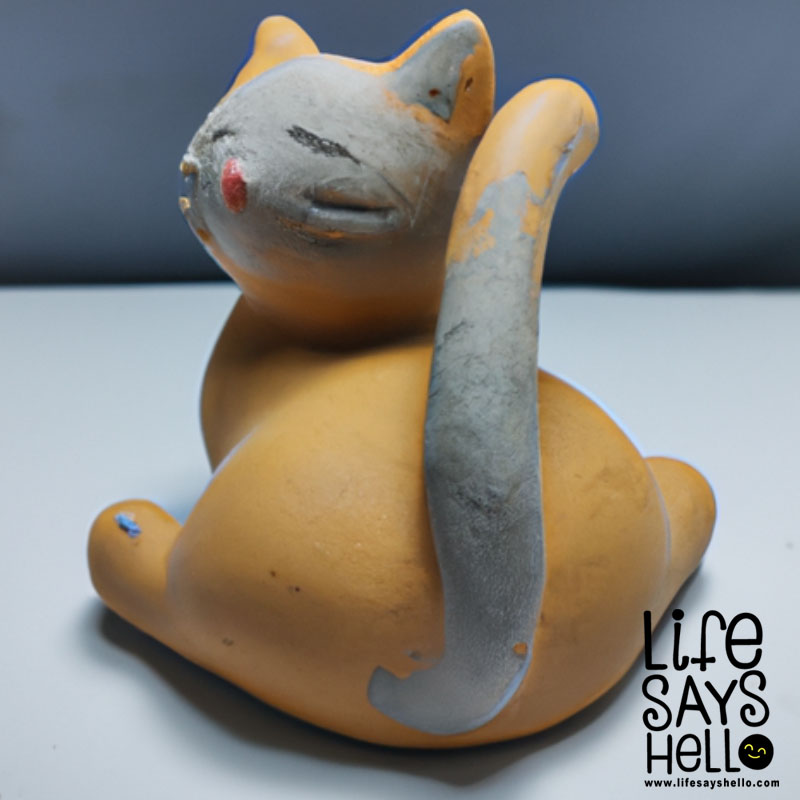Why Do Cats Arch Their Backs? The Surprising Reasons Behind This Cat Behavior

Have you ever noticed your cat arching their back? This peculiar behavior is common in cats and can mean a variety of different things. Cats arch their backs for many reasons - stretching, playing, feeling threatened, showing affection, and more. By understanding what your cat is trying to communicate through this posture, you can better respond to their needs. Keep reading to uncover the many explanations behind why cats arch their backs and what you can learn from it.
An Introduction to Cat Back Arching
Cats are incredibly flexible animals thanks to their anatomy. They have more vertebrae than humans, allowing them to twist and arch their spines in ways no other animal can. When a cat arches its back, it is voluntarily flexing its spine upwards into a U-shape. Often, this posture is accompanied by other behaviors like purring, meowing, or rubbing against legs. The context of when and how a cat arches can provide insight into their motivation.
Back arching is a normal part of cat communication and behavior. It can signify many different meanings from playfulness to defensiveness. Cats use body language like arching to express themselves to humans and other animals. By tuning into the nuances of your cat's signals, you can nurture a deeper bond and understand their needs better.
When your cat's back is arched, pay close attention to their entire body posture. Look at their ears, eyes, tail, fur, vocalizations and overall demeanor. The context will help you decipher the reason behind the arch. With time and observation, you can become fluent in your cat's non-verbal language.
Reason #1: Stretching and Playing
One of the most common reasons for cat back arching is stretching and playing. Cats have extremely flexible spines with around 53 vertebrae, over twice the number in humans. All these vertebrae allow them to arch their backs dramatically for a satisfying stretch.
You'll often witness long, extended arches when your cat stretches after napping or sleeping. This posture helps elongate the spine and flex all those vertebral joints. Stretching their back is a great way for cats to fully wake up their body and release any tension or stiffness. It's the feline version of a morning yoga routine!
Playful arching may involve less dramatic shapes as cats twist and pounce. The arched back allows cats to flex their core muscles for optimal pouncing power. When cats enter intense play mode, like chasing catnip toys or batting ping pong balls, they'll dynamically arch to tap into their agility. Their prey drive kicks in and the arched back aids their reflexes.
When you notice arching paired with energetic play, relaxed eyes and cheerful chirping, you can be confident it stems from feeling frisky. Engage your cat in active play sessions when they display this carefree arching. It satisfies their predatory instincts and prevents unwanted "hunting" of your ankles or furniture!
Reason #2: Feeling Threatened or Fearful
While arching during play comes from a positive place, cats may also arch their backs when feeling threatened or fearful. If your cat encounters a person, animal or situation causing anxiety, they may reactively arch up defensively. This posture helps them appear larger and more intimidating to ward off perceived threats.
Fearful or threatened arching is usually accompanied by other classic defensive body language. Their ears may flatten back against the head and their fur will stand on end. Low growls or hostile yowling often pair with this body stance. The overall vibe is one of tension and apprehension.
Your cat may be responding defensively to a new visitor in the home, loud noises like thunder or construction, or an unfamiliar animal outside. Any situation causing distress can trigger the arched back reaction. Understanding the trigger will allow you to mitigate it or give your cat reassurance.
If your cat directs fearful arching towards you, stay calm and avoid prolonged eye contact. Give them space to relax and coax them gently when they seem open to interaction. Identifying and limiting stressors in their environment can help minimize defensiveness long-term.
Reason #3: Feeling Excited or Happy
A pleasantly arched back can also demonstrate your cat feels excitement or happiness. When your cat greets you at the door with an arched back and loud purring, they're elated for your return. The posture reflects their joyful mood.
Happy cats pair arching with other positive body language like relaxed eyes, upright ears and a vibrating tail. They'll rub against their owner's legs while arched to spread facial pheromones. Your cat may walk around with their back arched up when they're in an extremely good mood.
Exuberant arching requires no action on your part beyond appreciating your cat's affection.
Give them some extra playtime or treats to celebrate their cheerful state. Just like humans, cats experience ups and downs in their emotions. When your cat hits an emotional high note, their arched back makes it obvious.
Moments of excitement can also produce a playful arch. If your cat races around with an arched back after spotting a bug or leaf fluttering outside, they're feeling pumped up. These bursts of energy prompt arched stretching and pouncing.
Interactive toys like feathers or laser pointers will also get their back arched in anticipation. Satisfy their excitement with an active play session.
When your cat greets you at the door with an arched back, loudly purring, they're elated for your return. The posture reflects their joyful mood. Exuberant arching requires no action beyond appreciating your cat's affection. Give them some extra playtime or treats to celebrate their cheerful state. Just like humans, cats experience emotional ups and downs. When your cat hits a high note, their arched back makes it obvious.
Reason #4: In Pain
While an arched back often reflects positive emotions, it can also signal your cat is in pain or injured. Cats naturally hide discomfort to avoid appearing weak to predators. But persistent arching paired with behaviors like growling, flattened ears and enlarged pupils may indicate suffering.
Cats who have been injured through accidents or fights frequently arch their backs. The posture pulls pressure off the sore area to provide temporary relief. Changes in litter box habits, appetite and personality can also accompany painful arching.
If you suspect your cat arches due to discomfort, get them checked by a vet immediately. Common sources of pain leading to arching include urinary tract infections, pancreatitis, fractured bones, dental disease and abdomen issues. Veterinary experts can pinpoint the problem and prescribe appropriate treatment.
Never ignore new or worsening back arching in senior cats either. Conditions like arthritis and muscle stiffness progress with age. Your aging cat may increasingly arch their back to combat joint and body aches. Managing their pain will help improve quality of life.
In multi-cat households, cats with medical issues often hide discomfort to avoid bullying. Ensure all cats get regular vet check-ups to catch problems early. Addressing pain-induced arching quickly improves welfare and recovery odds.
Reason #5: Affectionate Display
When cats arch toward a person it also demonstrates affection. By arching their back during petting, your cat signals trust and contentment. The posture gives you better access to their head and back for optimal scratching. A cat who didn't feel bonded with you would likely avoid this vulnerable position.
Happy cats will often pair arching with loud purring and kneading paws. They close their eyes and relax into your lap. The arched back mirrors their calm inner state. Ears remain upright and their tail wraps around your arm or leg.
Think of arched snuggling as the cat equivalent of a hug. It represents a close social bond. Respect this display of trust by keeping petting gentle and avoiding overstimulation. Watch for any distress signals like swishing tails or rotated ears.
Exchange affection by massaging areas your cat arches toward. Use long strokes down the full length of their back. Gently rub behind the ears and under the chin too. Keep things calm to sustain the relaxing mood.
Why Cats Arch Their Backs When Pet
You now understand the range of motivations behind cat back arching. But why do cats arch so frequently when being petted? Petting provides intense pleasure, comfort and intimacy for cats when done properly. The arched posture during petting allows your cat to fully indulge in these positive sensations.
By arching up, your cat gives you better access to their head and back. They want you to be able to scratch and massage all their favorite spots. An arched back also stretches out the skin to feel more satisfying scratches.
Cats only arch around trusted humans with whom they share a bond. The posture makes them vulnerable, so they'll only reveal their belly or back if they feel safe. Frequent arching during petting signals your relationship is solid.
An arched back demonstrates a cat feels completely calm and relaxed around you. They sink into a zen state thanks to your comforting touch. Their guard is down and they can release any worries. Through arching, cats display deep contentment.
Understanding Your Cat's Arching Motivations
As you can see, the reasons behind your cat's arched back can vary widely based on context. By paying attention to their entire body language, as well as what precedes the arching, you can better understand the motivation behind it. Use this knowledge to properly respond to your cat's needs in the moment.
Watch for key signals like ear position, fur texture, tail motions and vocal sounds to get the full story. For example, are their ears rotated back or forward? Is their fur smooth or standing on end?
Arching from playfulness or happiness deserves a cheerful reaction - engage your cat with toys or affection. Fearful arching calls for space and patience. Pain-induced arching requires a vet visit. Show your cat you understand what they are trying to communicate.
With time, you'll be able to read your cat's arching motives from even subtle cues. For example, you may notice a particular meow paired only with painful arching. Use clues like this to respond quickly to their needs.
The key is observing carefully and looking at the full context surrounding the arched back. Avoid making assumptions or reacting too fast. Tuning into feline body language will strengthen your bond exponentially.
Conclusion: Decoding Kitty's Cryptic Clues
Cat back arching has many different meanings, ranging from frisky to fearful. Cats rely on this peculiar posture to express a variety of sensations, needs and emotions. By paying attention to your cat's signals, you'll become fluent in translating their arching motivations.
Stay watchful for accompanying behaviors like tail swishing, ear flattening and chattering. These clues complete the picture. Understanding your cat's communications will bring you closer and improve their health and happiness.
The next time your cat saunters over with their back dramatically arched, take a beat to observe before reacting. Check for playfulness or distress cues. Then you can respond appropriately based on what kitty is trying to tell you! With some detective work, you'll master reading their cryptic body language.




Comments